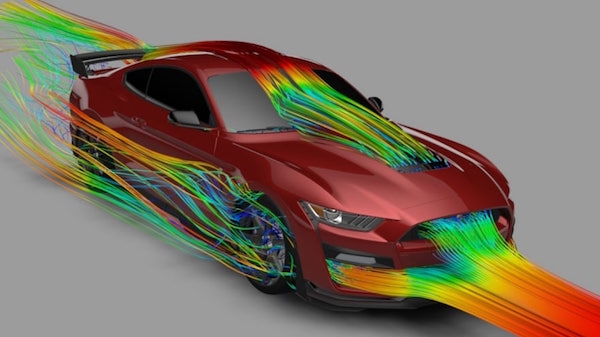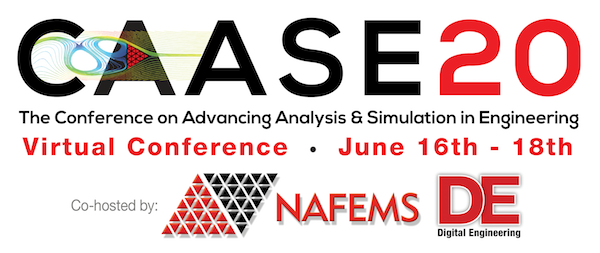Ford and the Future of Simulation
At the CAASE20 virtual event, the automaker will discuss its use of leading-edge simulation and additive manufacturing technologies.

Ford will lead multiple sessions at the upcoming CAASE20 virtual event, June 16-18. Image courtesy of Ford.
Latest News
June 2, 2020
Ford Motor Company will have a substantial presence at the upcoming CAASE20 virtual conference, co-presented by NAFEMS and Digital Engineering. Representatives from Ford will lead a variety of conference sessions focused on the use of simulation, additive manufacturing and new design approaches to aid in lightweighting and the integration of new technologies in its vehicles.
In “AI‐Guided Simulation” on June 17, Alejandro Ayala, product development business operations manager at Ford, will discuss the use of artificial intelligence (AI) in simulation as a way to help address increasing engineering complexity. According to Ford, AI can help automate complex design processes to improve efficiency and prevent errors.
In the presentation, Ayala will also address the challenges associated with changing the engineering culture and shifting to a more customer-centric approach. The primary tools to enable this shift will be AI, SMBSE, virtual simulation and integration platforms that can ensure a development ecosystem “in accordance with the never‐ending race to innovate and satisfy the global markets.”
According to the presentation abstract, “The 2020 decade will be not just a full digital expansion, but also a smart environment in all the products and services. Shared hardware, software and computing services will reduce the cost of developing smart tools, so the usage of AI will be a must to compete and to gain competitive advantages in the global arenas.”

Also on June 17, Abhay Bhivare, ADAS Simulation and Virtual Validation at Ford, will present “Automation and Design Space Exploration for Improved ADAS Feature Performance.” The growth of advanced driver assist systems (ADAS) has proven challenging for engineers. Customers are often dissatisfied with certain aDAS features and performance, whil validation of the systems requires advanced MBSE methods—there are simply too many potential scenarios to effectively conduct physical testing.
During the session, Ford will outline how simulation and virtual validation could be used to validate the fully assisted park assist feature (FAPA).
“It is obvious that in real-world situations, there is a significant variation in the parameters that define the parking spot and the vehicle being parked,” Bhivare says in the abstract. “These variations result in a significantly larger number of possible scenarios compared to what is defined by the standard validation test. Consequently, simulation is the only way to assess the performance of FAPA under the real-world situations.”
Ford’s method integrates MBSE simulation and optimization using FAST optimizer with a genetic algorithm. The genetic algorithm is used to create the required design space in order to perform a multi‐objective optimization using a large number of design parameters and scenarios.
In another presentation, Ford’s Christian Castro will discuss the use of additive manufacturing for cost and weight reduction strategies in automotive components. Attendees will learn how additive manufacturing can be applied to weight/cost improvement strategies for automotive components.
Ford will also present a session titled “CAE‐Driven Accelerated Durability Test for Carbon Canister Bracket Assembly.”
According to the abstract, “Although, the durability performance of the carbon canister assembly can be assessed using FEA and fatigue calculations, some components in the assembly can be so complex that it is not possible to produce a detailed computational model for the system; hence some degree of physical testing is unavoidable. On the other hand, since cost and time are very critical in today’s product development processes, implementing a reliable and efficient accelerated test is a very desirable element in designing a robust and efficient carbon canister.”
Ford will outline an accelerated durability test based on a Power Spectral Density (PSD) profile. This process involves using validated CAE models to compare the stress and acceleration response of different carbon canister designs to the proposed PSD versus an existing (time‐consuming) PSD.
Ford’s Mario Felice, global manager for Powertrain Calibration (also a NAFEMS council member), will be on hand to discuss using CFD to design an optimal urea mixer in a diesel exhaust system on June 16. CFD can be used to improve the mix of urea in the systems used to reduce NOx emissions. Ford Technical Expert Georg Festag’s presentation will focus on using system simulation to optimize powertrain NVH.
Festag will also lead a presentation on using AI to perform a heuristic search for optimal breakpoints in engine mapping. Traditional engine mapping by calibrators relies on personal experience and trial and error, a process which is slow and sometimes error-prone. Festag will discuss using AI to select optimal load break points from the timing tables.
Ford is also scheduled for a presentation on using CAE for fan blade durability assessment. Using CAE simulation, Ford can improve component performance without expensive and lengthy physical testing by “capturing critical speeds and predicting stress levels at such conditions on the whole component.”
For more information, and to register for CAASE20, visit www.nafems.org/caase20.
More NAFEMS Coverage
Subscribe to our FREE magazine, FREE email newsletters or both!
Latest News
About the Author
DE’s editors contribute news and new product announcements to Digital Engineering.
Press releases may be sent to them via DE-Editors@digitaleng.news.






